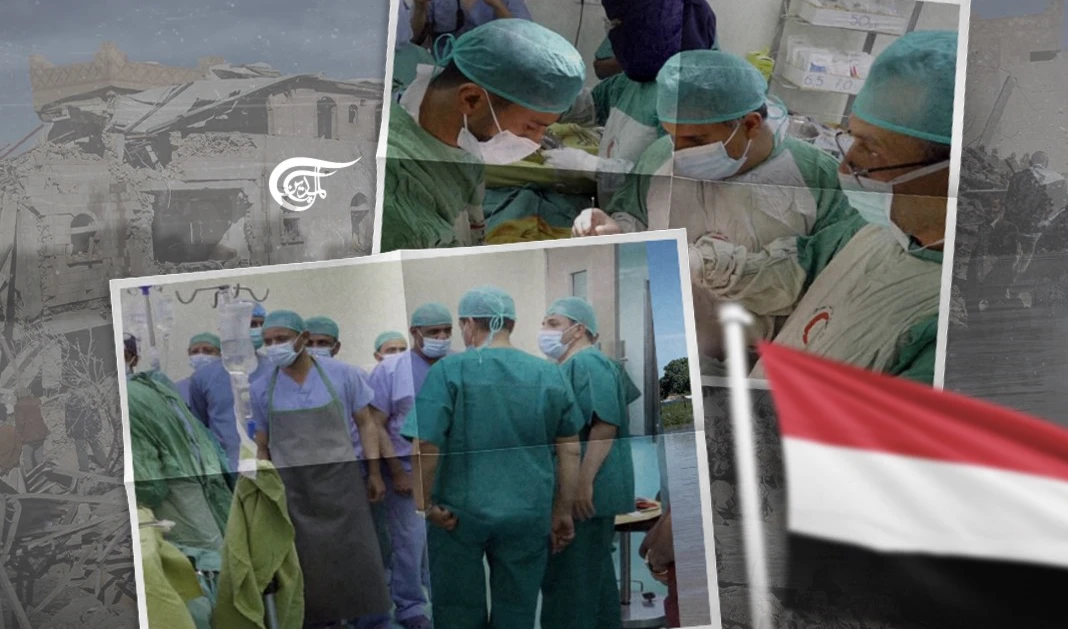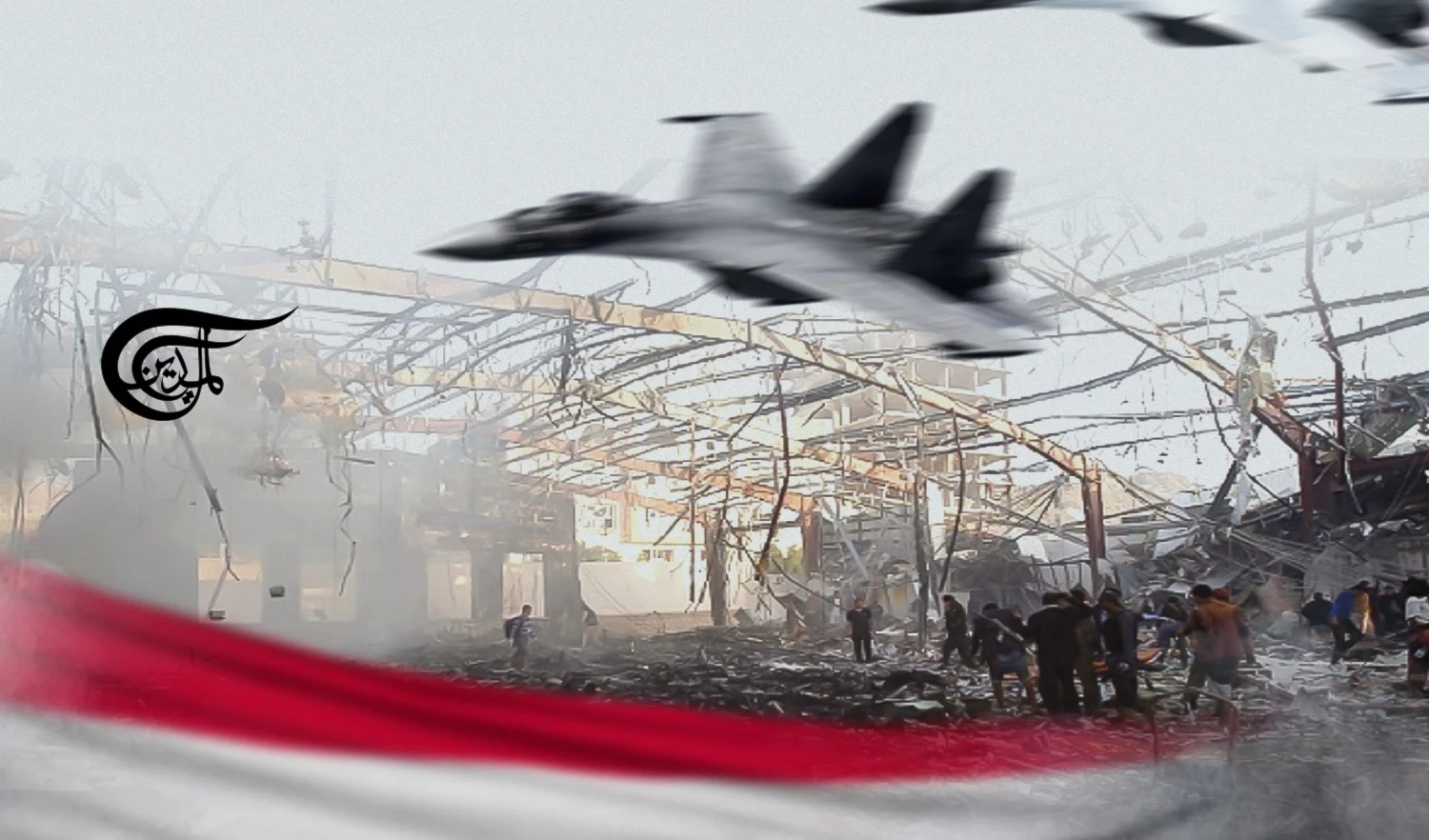Climate change crisis: Heavy rains damage ancient houses in UNESCO-listed Old City of Sanaa
-

Climate change crisis: Heavy rains damage ancient houses in UNESCO-listed Old City of Sanaa
Due to the rainy cloud that formed over the UNESCO-listed Old City of Sanaa City at noon on August 17, Hamid Ahmed Al-Habbari rushed back to inspect his second home before the rain starts to fall, because he had already lost his first to rain during the last couple of years.
-

Hamid Al-Habbari inspect on August 17, 2022, his first house damaged in the last couple of years (Naseh Shaker/Al Mayadeen English)
"This house gradually collapsed due to heavy rain in the last couple of years," Hamid Al-Habbari told Al Mayadeen English with his wife standing beside him at the common wooden gate of his two houses. "I've not been able to restore it for lack of money."
Al-Habbari has two close houses in Mosa Neighborhood; a two-story building overlooking the sub-street, south of the city, and a three-story building overlooking Meqshamat Mosa, north of the city.
"I have been living under the mercy of the heavy rains since the roof of one room in my second house partially collapsed during the recent rains," Al-Habbari said. "I have no other place to seek shelter in if this house collapses."
Al-Habbari's two houses are among 5 demolished by heavy rains and 40 others destroyed on August 9, according to the Civil Defence in Ansar Allah-led National Salvation Government.
Mahdi Arhab, director of the Old Sanaa District, confirmed to the state-run Saba news agency the demolition of the five houses and pointed out that the roofs of 18 houses collapsed, while 22 others suffered from water leakage.
Arhab added that "380 houses... are facing the imminent danger of collapsing... because of the downpours during the last two weeks."
Talaat Al-Asharjabi, the spokesperson for the Supreme Council for Humanitarian Affairs, said, "91 people died [across Yemen] and more than 24k families were affected by the torrential rains during the last period."
According to the Islamic Relief, "Yemen's environment is also suffering from the effects of the prolonged crisis. Yemen was already at risk of floods, drought, and heavy sandstorms, but further damage is being wrought by a surge in deforestation and desertification driven by the crisis."
Ammar Abdulbaset Nagi Aldumini of Islamic Relief in Yemen said in March 2022 that “climate change is one of the most pressing issues of our time and often those who have contributed least bear the brunt of its ill effects. Yemen is no exception. Climate change is worsening the humanitarian crisis in the country.”
In a statement issued on August 13 titled "UNESCO Supports Historic Cities in Yemen Facing Increasing Climate Change Challenges," the organization expressed its concerns about the impact of the recent torrential rains and flooding on the livelihoods of local communities in Yemen, as well as the loss of invaluable historic properties.
"The preservation of fragile buildings has been undermined in recent years due to the socio-economic impact of the war, which has prevented homeowners from carrying out the periodic maintenance necessary to ensure their structural integrity," the statement read.
"UNESCO has therefore been working alongside local stakeholders and partners to safeguard this heritage, by implementing emergency interventions, rehabilitating houses, and building capacities."
"In the Old City of Sanaa, 213 historic buildings have been rehabilitated over the past four years with the support of a UNESCO/EU project," the statement added.
'My heart is aching for me'
However, Al-Habbari's two-story building was not among the 213 historic buildings that UNESCO said it rehabilitated over the last four years in the Old City of Sanaa.
"We always receive officials from UN and local authorities who only take images of my house and do nothing for its maintenance," said Al-Habbari, who received during the last couple of years a kit containing a "plastic sheeting" only, which he now uses to cover the roof of his second house's room after it collapsed partially.
"Now the plastic sheeting has eroded," he told Al Mayadeen English as he tore the plastic sheet apart to show how it had eroded as we went to the rooftop of his second home overlooking the Meqshamat Mosa.
Al-Habbari believes that his two ancient houses were built some 200 years ago. He lives in his house with his wife and only son. He said he was planning to get him married, but it was his room whose roof collapsed.
-

Hamid Al-Habbari inspects, on August 17, 2022, his first house damaged (Naseh Shaker/Al-Mayadeen English)
"I want the state or the UN to rehabilitate my houses, at least the ceilings to protect my family from the rain," Al-Habbari said.
"Today, I can't eat, drink, or sleep safely," Al-Habbari said. "My heart aches badly. The smell of mud is driving me crazy."
-

Climate change crisis: Heavy rains damage ancient houses in UNESCO-listed Old City of Sanaa
UNESCO named the Old City of Sanaa a world heritage site in 1986. It said the city has been "inhabited for more than 2,500 years. In the 7th and 8th centuries, the city became a major center for the propagation of Islam."
It added that "this religious and political heritage can be seen in the 103 mosques, 14 hammams, and over 6,000 houses, all built before the 11th century."
All of the city's buildings are built from burnt mud bricks or adobe from the second floor and up, with lower ground floors built from stones that are windowless for they are used as stores for animals, firewood, or working spaces.
Ceilings are built from wood and covered from the outside and inside with mud, which is adorned on the inside by white gypsum. However, the heavy rains have caused water leakages resulting in the collapse of the ceilings and sometimes the entire building.
'Only the ceilings'
-

Hamid Al-Habbari pointing on August 17, 2022, at the ceiling of his kitchen that fell on cooking kits (Naseh Shaker/Al Mayadeen English)
Then he took me on a tour of his second three-story building overlooking Meqshamat Mosa and showed me a room whose ceiling collapsed partially. The family had placed some buckets underneath to collect water running down.
"Look how I was pouring the water all night," his wife said as she came closer to me showing footage on her mobile phone taken by her son while she was pouring water from one basin to another before pouring them down the sewage.At 12:37 pm on August 17, and as Al
Habbari and I stood on the rooftop of the room enjoying the scene overlooking the Meqshamat Mosa with a mosque on the eastern side of the Meqshamat, the Imam was making the call for the Dhuhr prayer.
However, the voice of Iqama in the background was interrupted by the noisy sound of the red plastic sheeting hit by the wind, since Al-Habbari had already used it to cover the hole to prevent water from pouring into the room.
"When it is cloudy, I feel grief and pain rather than happiness, because I am afraid that the rest of the roof will collapse over me and my wife."
"I want the organization to rehabilitate the ceilings only. We don't want them to rebuild the house again; only the ceilings," Al-Habbari told Al Mayadeen English.
Missiles played a role
Hussein Al-Kabzari said the rains have been threatening 26 individuals who live in his father's house located in the Mosa neighborhood. Rainwater leaked through causing the ceiling to collapse over the head of his brother's wife. But in his opinion, it is not only the rain that caused the collapse.
"The rains and the [Saudi-led coalition] missiles that shocked houses when Noqom Mountain was targeted led to the collapse of the ceiling," Al-Kabzari told Al Mayadeen English as he stood on the rooftop of his house on August 17.
-

Hussein Al-Kabzari in the room of his brother on August 17, 2022, that fell on his brother's wife while sleeping (Naseh Shaker /Al Mayadeen English)
Al-Kabzari house is nearly 2km away from Noqm Mountain that the Saudi-led coalition used to target with missiles and bombs since the early days of the aggression on Yemen considering that the former regime of Ali Abdullah Saleh used it as missiles depots but collateral damages were inflicted on civilians and their properties due to the bombardment.
"Roof of my brother's room collapsed on his wife while she was sleeping," Al-Kabzari added, pointing out that they can't rehabilitate their house without support from the state or the UN.
"I'm a motorcycle driver and can hardly bring food to the table. How can I reconstruct the roof?" he wondered. "We are not able to buy one sack of Gypsum to rehabilitate the roof."
"We are afraid the total roof of the house will collapse," Al-Kabzari explained. "It is going to cause a disaster to 26 individuals and collateral damages to the neighbors' houses."
In the past, there was some rain leakage, but the roof collapsed from inside the room just recently and wide fissures appeared on the walls," he told Al Mayadeen English.
Al-Kabzari, who said the house was built by his great-grandfather, urged local authorities and the UN to support him "in rehabilitating the roof to be made from wood or cement rather than the poor tree wood covered by mud as it has already eroded with time."
"When we see a rain cloud, we pray that God does not let the rain come down on us for fear of damages," Al-Kabzari noted.

 Naseh Shaker
Naseh Shaker
 9 Min Read
9 Min Read











